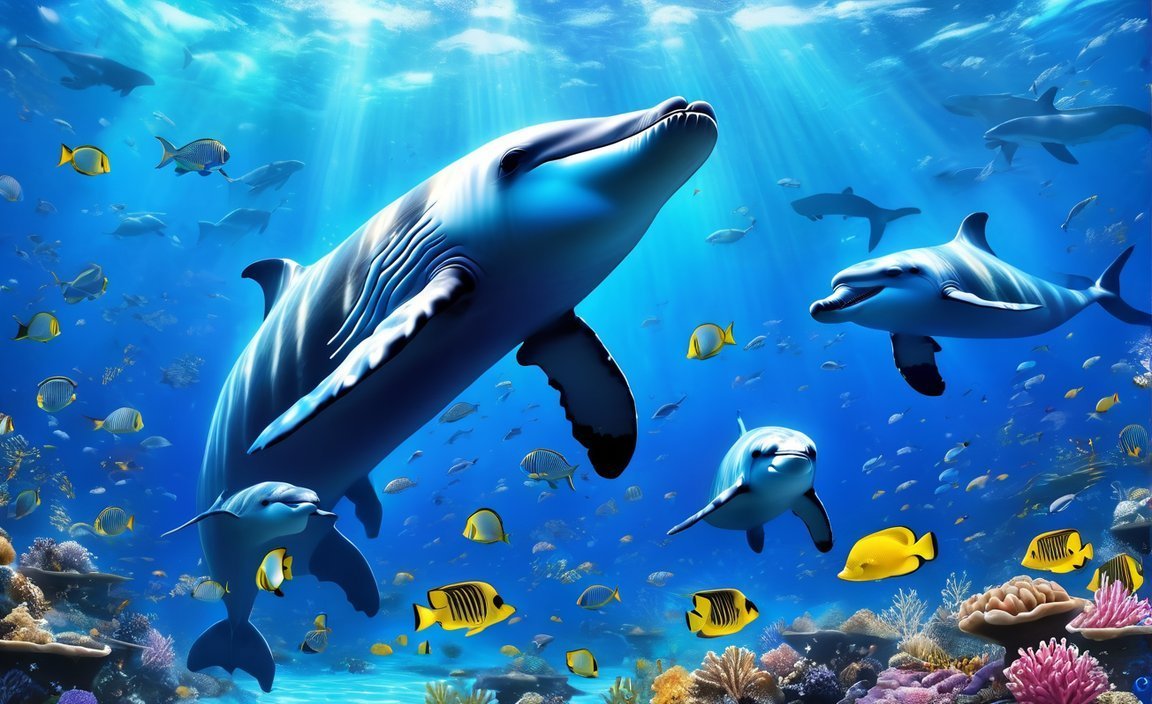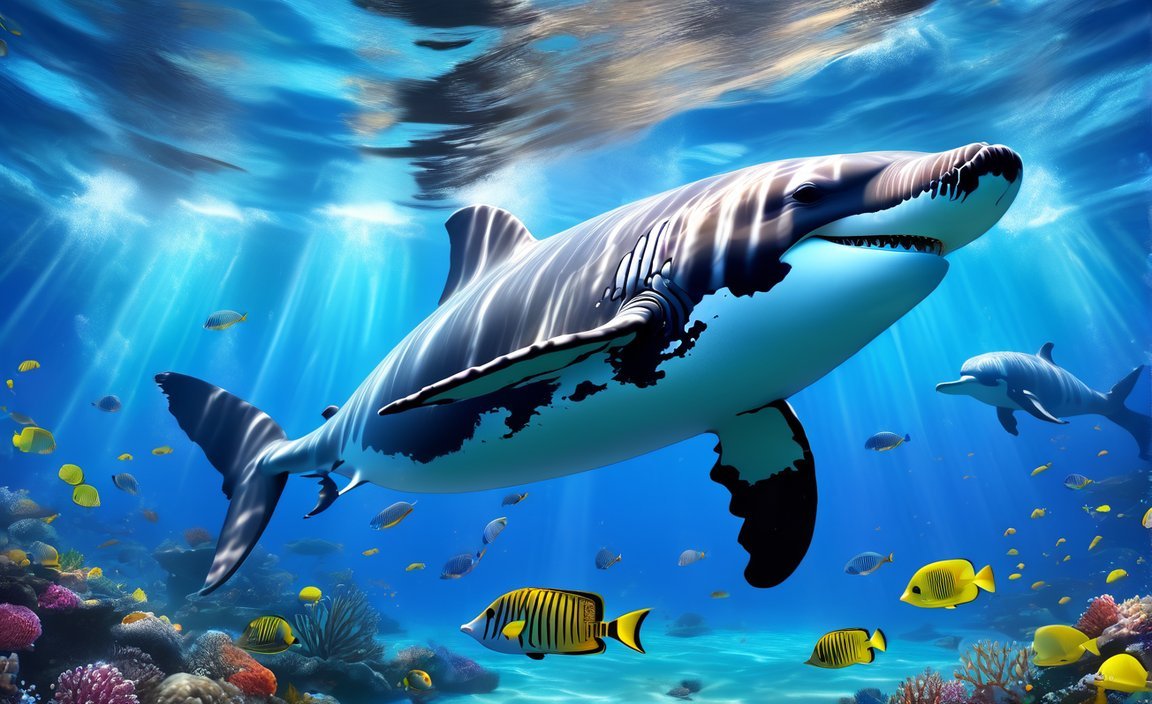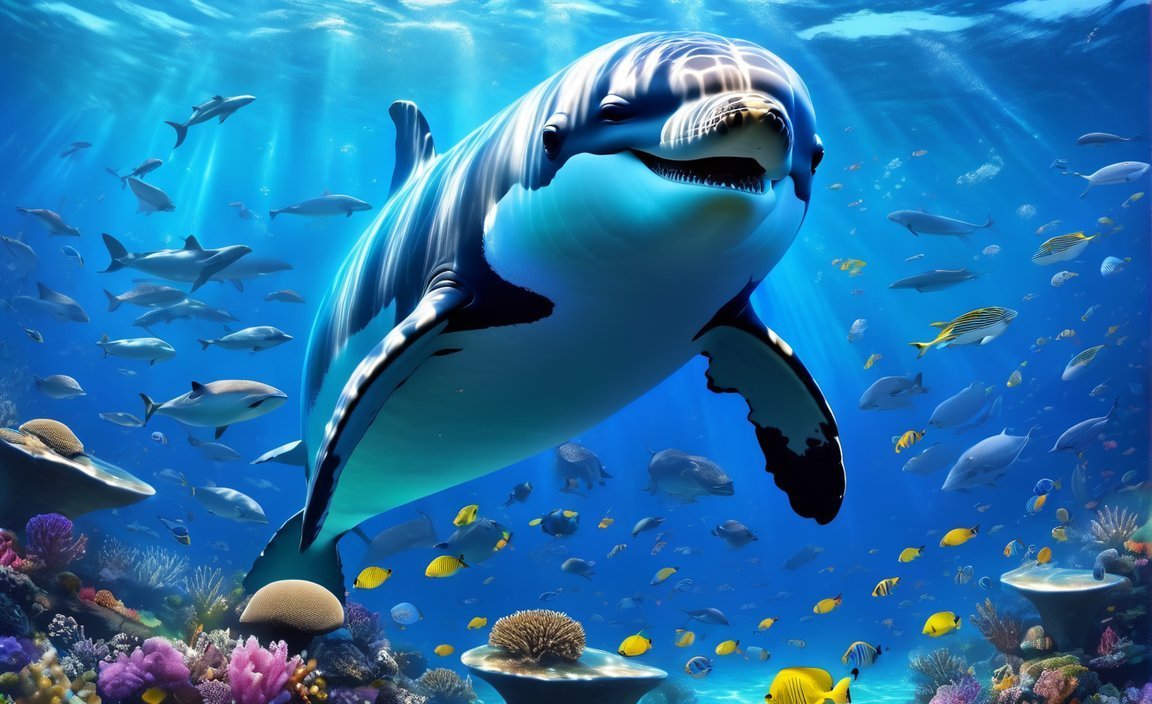Discover 10 Fascinating Marine Mammal Facts. Dive into the captivating world of marine mammals and uncover the secrets of these incredible creatures. From majestic whales to playful dolphins, marine mammals have long captured our hearts and ignited our curiosity. In this article, we will explore 10 fascinating facts about these enigmatic beings, shedding light on their unique behaviors, incredible adaptations, and vital role in our planet’s ecosystems. Prepare to be amazed as we delve into the extraordinary lives of these remarkable marine creatures.

Key Takeaways:
- All marine mammals are excellent swimmers and have fins or flippers to assist them.
- Many marine mammals have been hunted in the past for their fat or oil, leading some species to the brink of extinction.
- Water mammal babies are capable of swimming at high speeds.
- Some marine mammals possess exceptional underwater vision.
- Marine mammals span a wide range of sizes, from small seals and porpoises to the colossal blue whale.
- Cetaceans and pinnipeds have the remarkable ability to dive to great depths in order to feed, thanks to the use of digital tags that track their movements, direction, and depth over time.
For more information, you can visit:
– Easy Science for Kids: Link 1
– Woods Hole Oceanographic Institution: Link 2
10 Facts About Marine Mammals
Marine mammals, the fascinating creatures of the sea, encompass a diverse range of species that have captivated the human imagination for centuries. From their incredible swimming abilities to their vital ecological roles, these marine mammals possess intriguing characteristics that make them truly extraordinary. Let’s dive into the world of marine mammals and uncover 10 captivating facts about them!
1. Excellent Swimmers
All marine mammals are natural-born swimmers. Equipped with specialized fins or flippers, they effortlessly navigate the vast ocean waters. These powerful appendages not only aid in propulsion but also provide stability and maneuverability.
2. Hunted for Their Fat
Unfortunately, many marine mammals were hunted in the past for their valuable fat or oil. This relentless pursuit pushed some species to the brink of extinction. Thankfully, conservation efforts have contributed to their recovery, but their populations still face challenges in certain regions.
3. Speedy Swimmers from Birth
Water mammal babies possess an innate swimming prowess. They are remarkably nimble and can swiftly traverse the waters alongside their parents. Their ability to swim soon after birth ensures their safety and survival in their marine environment.
4. Remarkable Underwater Vision
Certain marine mammals have evolved with exceptional underwater vision. This visual acuity allows them to spot prey, navigate through complex seascapes, and engage in social behaviors essential for their survival. Their eyes have adapted to the underwater environment, enabling them to explore the depths with ease.
5. Varying Sizes
Marine mammals encompass an incredible range of sizes. From the petite seals and porpoises to the colossal blue whale, which holds the title for being the largest creature to have ever inhabited the Earth, these mammals showcase the vastness of nature’s creations.
6. Astonishing Diving Abilities
Many cetaceans and pinnipeds astound scientists with their incredible diving abilities. Recent technological advancements using digital tags have allowed researchers to record these animals’ movements, direction, and depth during their deep dives. The recorded data unveiled the astonishing depths these marine mammals can reach in their quest for food.
7. Echolocation for Navigation
Some marine mammals, such as dolphins and whales, possess the incredible ability of echolocation. By emitting sounds and listening to the echoes that bounce back, they can effectively navigate their surroundings and locate food sources. This unique adaptation showcases the remarkable intelligence and resourcefulness of these animals.
8. Complex Social Structures
Marine mammals exhibit intricate social structures, often living in tightly-knit communities. They engage in intricate communication behaviors, forming bonds within their groups. Observation of these social dynamics provides crucial insights into the cooperative nature of marine mammal societies.
9. Long-Distance Travelers
Migration plays a significant role in the lives of many marine mammals. These incredible creatures embark on long and often arduous journeys, traversing vast distances in search of food, suitable breeding grounds, or milder climates. Their ability to navigate across oceans highlights their innate navigational skills.
10. Ecological Significance
Marine mammals hold immense ecological significance. As apex predators, they help maintain the balance of marine ecosystems. By regulating prey populations and redistributing nutrients through their excrement, they contribute to the overall health and stability of oceanic environments.
Exploring these 10 fascinating facts about marine mammals offers a glimpse into their captivating world. From their unparalleled swimming abilities to their vital ecological roles, these creatures continue to amaze and inspire both scientists and nature enthusiasts alike. By understanding and appreciating these incredible beings, we can work towards their conservation and ensure their continued presence in our oceans.
Here are some interesting facts about different topics. Click on the links below to learn more:
- 10 facts about dogs in Hindi – अगर आप कुत्तों के बारे में और अधिक जानना चाहते हैं तो यहां क्लिक करें।
- 10 facts about ground pollution – भूमि प्रदूषण के बारे में 10 दिलचस्प तथ्य जानने के लिए यहां क्लिक करें।
- 10 facts about marine animals – समुद्री जीवों के बारे में 10 रोचक तथ्य जानने के लिए यहां क्लिक करें।
- 10 facts about ocean animals – समुद्री जीवों के बारे में 10 रोचक तथ्य जानने के लिए यहां क्लिक करें।
- 10 facts about pets – पालतू जानवरों के बारे में 10 दिलचस्प तथ्य जानने के लिए यहां क्लिक करें।
- 10 facts about sea animals – समुद्री जानवरों के बारे में 10 रोचक तथ्य जानने के लिए यहां क्लिक करें।
- 10 facts about slugs and snails – घोंघे और सांप के बारे में 10 दिलचस्प तथ्य जानने के लिए यहां क्लिक करें।
- 10 facts about snapping turtles – स्नैपिंग टर्टल के बारे में 10 रोचक तथ्य जानने के लिए यहां क्लिक करें।
Diverse Habitats and Ranges of Marine Mammals
Marine mammals are an incredible group of animals that inhabit a wide range of diverse habitats in our planet’s oceans. Let’s dive into the fascinating facts about their habitats and ranges.
The Vast Marine World
Marine mammals, including whales, dolphins, seals, sea lions, manatees, dugongs, polar bears, and sea otters, occupy different taxonomic groups and have adapted to various aquatic environments. They can be found in saltwater, brackish water, rivers, coastal shores, and even the open ocean. This diverse range of habitats allows marine mammals to thrive in different ecological niches and fulfill important roles within marine ecosystems[^1][^9].
Adaptations for Marine Life
Marine mammals possess remarkable adaptations that enable them to survive and thrive in their unique environments. One of their key adaptations is the ability to breathe air, just like their terrestrial relatives. This allows them to venture to the water’s surface to breathe before diving deep in search of food[^6].
Their specialized physiology also includes features like flippers, fins, and streamlined bodies, which provide them with the agility necessary for swimming, stability, and maneuverability. These adaptations have been finely tuned through evolution, allowing marine mammals to navigate the ocean currents and pursue diverse feeding strategies[^1][^5].
Habitat Diversity and Conservation
The distribution of marine mammals is complex and varied across the world’s oceans. Climate change and human activities have significant impacts on the optimal habitats and species richness of marine mammals. As their environments change, these magnificent creatures face challenges in finding suitable locations for breeding, feeding, and resting[^10].
Conservation efforts are crucial to safeguard the diverse habitats of marine mammals. By protecting their habitats and ensuring sustainable practices, we can maintain the delicate balance of marine ecosystems and support the continued existence of these awe-inspiring animals[^11].
Key Takeaways:
- Marine mammals inhabit diverse aquatic environments, including saltwater, brackish water, rivers, coastal shores, and the open ocean[^9].
- Their adaptations, such as the ability to breathe air and streamlined bodies, help them survive and thrive in marine habitats[^6].
- Climate change and human activities pose threats to the optimal habitats and species richness of marine mammals[^10].
- Conservation efforts play a vital role in preserving the diverse habitats of marine mammals and maintaining the health of marine ecosystems[^11].
Sources:
[1] National Oceanic and Atmospheric Administration
[5] ScienceDirect
[6] Science
[9] University of California Press
[10] PNAS
[11] National Center for Biotechnology Information
Unique Adaptations of Marine Mammals
Marine mammals have evolved incredible adaptations that allow them to thrive in their aquatic environments. These adaptations play a vital role in their survival, enabling them to efficiently navigate the water, regulate their body temperature, conserve water resources, and communicate effectively. In this article, we will explore the fascinating and unique adaptations of marine mammals that make them so well-suited to life in the sea.
Swimming Adaptations
One of the most remarkable adaptations of marine mammals is their ability to swim with exceptional speed and agility. Their bodies have evolved to reduce drag, with hydrodynamic forms that allow them to move through the water with minimal resistance. Marine mammals have modified appendages, such as flippers and tails, which are optimized for maximum propulsion and maneuverability. These adaptations enable them to navigate through the ocean with remarkable ease and efficiency.
Thermoregulation
Maintaining body temperature is critical for the survival of marine mammals in cold aquatic environments. They have evolved unique adaptations for thermoregulation. Their large body size with a small surface-to-volume ratio helps reduce heat loss. Additionally, they possess a thick layer of blubber, which provides insulation against the cold. The extremities of marine mammals have complex circulatory systems that help conserve and dissipate heat as needed. Furthermore, young pinnipeds and cetaceans rely on high-fat milk to maintain their body temperature as they grow rapidly.
Water Conservation
In the vast ocean, fresh water is a scarce resource, and marine mammals have adapted to minimize water loss. Unlike terrestrial mammals, marine mammals rarely drink freshwater but instead rely on the water present in their food, inspired air, and blubber. They have developed adaptations to minimize water loss, such as concentrated urine and efficient kidneys. These adaptations allow them to conserve water and thrive in their marine habitats.
Sensory Adaptations
Marine mammals have also evolved remarkable sensory adaptations to navigate and communicate effectively in their underwater world. They communicate using sound, with many species utilizing echolocation to locate prey and navigate through the ocean. Their acute tactile senses, along with well-developed facial whiskers in pinnipeds and fissipeds, help them gather information about their environment. These adaptations allow marine mammals to effectively navigate, find food, and interact with their surroundings.
Key Takeaways:
- Marine mammals have hydrodynamic body forms and modified appendages for efficient swimming.
- Their adaptations for thermoregulation include a large body size, blubber insulation, and circulatory systems in extremities.
- Marine mammals minimize water loss through adaptations like concentrated urine and efficient kidneys.
- They communicate using sound and have well-developed tactile senses and facial whiskers.
- These unique adaptations allow marine mammals to thrive in their marine environments.
For further reading and information on marine mammal adaptations, you can visit the following sources:
- Marine Mammal Adaptations | Alaska Sea Grant
- Marine Mammals: Adaptations for an Aquatic Life | SpringerLink
These sources provide additional details and examples of marine mammal adaptations in various species.
The Ecological Roles and Importance of Marine Mammals in Ecosystems
Marine mammals play vital ecological roles in marine ecosystems, serving as top predators, filter feeders, and herbivores. Understanding the significance of marine mammals in maintaining ecosystem balance is essential for conservation efforts. In this article, we explore the various ecological roles of marine mammals and their importance in marine ecosystems.
Marine Mammal Taxonomic Groups
- Marine mammals belong to various taxonomic groups, including pinnipeds (seals, sea lions, and walruses), cetaceans (whales, dolphins, and porpoises), sirenians (manatees and dugongs), sea otters, and polar bears.
- Each taxonomic group evolved from different land mammal ancestors, independently returning to the ocean.
Ecological Roles of Marine Mammals
- Top Predators: Certain marine mammals, such as killer whales and walruses, serve as top-level predators in marine ecosystems, regulating prey populations and maintaining ecosystem balance.
- Filter Feeders: Baleen whales are filter feeders that consume immense volumes of zooplankton, playing a crucial role in controlling plankton populations and nutrient cycling.
- Herbivores: Manatees, as herbivorous marine mammals, graze on seagrasses and vegetation, influencing the structure and distribution of seagrass habitats.
Impact on Communities and Ecosystems
- Marine mammals have the potential to consume significant portions of prey populations, influencing community dynamics and trophic cascades.
- By controlling prey populations, marine mammals shape the structure and abundance of lower trophic levels, ultimately affecting the entire food web.
- Their movement patterns and foraging behaviors may also shape the distribution and abundance of prey species, indirectly influencing ecosystem structure.
Significance as Ecosystem Sentinels
- Due to their dependence on marine ecosystems, marine mammals serve as prime sentinels of ecosystem change.
- Their ability to integrate and reflect ecological variations across large spatial and temporal scales makes them valuable indicators of ecosystem health.
- Monitoring marine mammal populations can provide insights into the overall health and functioning of marine ecosystems.
Key Takeaways:
- Marine mammals play diverse and significant ecological roles in marine ecosystems as top predators, filter feeders, and herbivores.
- They regulate prey populations, control plankton populations, and shape the structure and abundance of lower trophic levels.
- Marine mammals serve as important indicators of ecosystem health and facilitate our understanding of ecosystem dynamics.
- Recognizing the ecological significance of marine mammals is crucial for effective conservation and management efforts.
References:
- National Oceanic and Atmospheric Administration: Marine Mammals
- ResearchGate: Role of marine mammals in aquatic ecosystems

FAQ
Q1: What are some interesting facts about marine mammals?
A1: Some interesting facts about marine mammals include their excellent swimming abilities, past hunting for fat or oil, the quick swimming skills of their babies, their excellent underwater vision, and the wide range of sizes they can range from, from small seals and porpoises to the largest animal ever, the blue whale.
Q2: How deep can marine mammals dive while feeding?
A2: Many cetaceans and pinnipeds can dive to remarkable depths while feeding. These feats have been recently discovered using digital tags that record the animals’ movements, direction, and depth over time.
Q3: How are marine mammals classified?
A3: Marine mammals are classified into four different taxonomic groups: cetaceans (whales, dolphins, and porpoises), pinnipeds (seals, sea lions, and walruses), sirenians (manatees and dugongs), and marine fissipeds (polar bears and sea otters).
Q4: What role do marine mammals play in marine ecosystems?
A4: Marine mammals play various ecological roles, including being herbivores, filter feeders, and top predators. They contribute to controlling prey populations, shaping the structure and abundance of lower trophic levels, and maintaining overall ecosystem balance.
Q5: Why are marine mammals important for monitoring ecosystem health?
A5: Marine mammals serve as sentinel species for monitoring the health of marine ecosystems. Their dependence on marine environments and ability to integrate and reflect ecological variations across large scales make them valuable indicators of ecosystem health. Monitoring their populations provides insights into overall ecosystem functioning.
- Senior at What Age: Benefits & Eligibility Guide - March 29, 2025
- Unlocking Senior Benefits: How Old is a Senior? Your Complete Guide - March 29, 2025
- Master Russian Politeness:A Guide to Saying Please - March 29, 2025
















